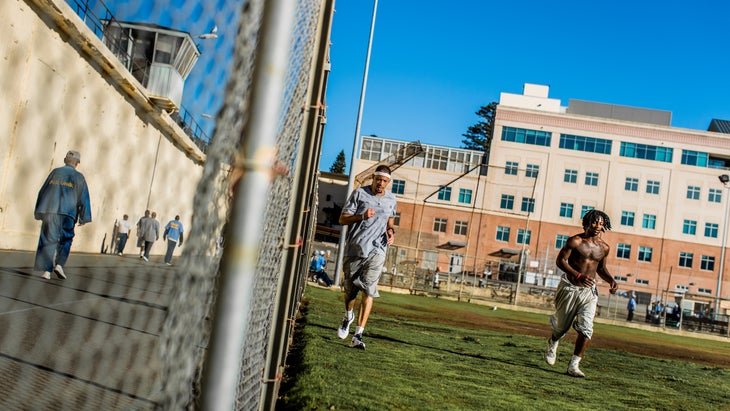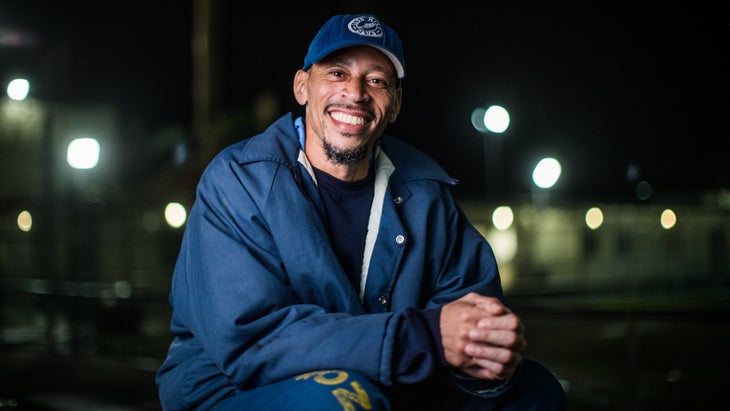New perk! Get after it with local recommendations just for you. Discover nearby events, routes out your door, and hidden gems when you sign up for the Local Running Drop.
Rahsaan Thomas still remembers immense leg cramps the day he completed his first marathon in 2017. On a cold Friday morning in November, he tied up a pair of donated white-and-grey Nikes and pounded around a quarter-mile loop of gravel, dirt, and concrete in a yard surrounded by barbed wire fences at San Quentin State Prison, a maximum-security facility 25 miles north of San Francisco, California.
Thomas grew up in Brownsville, in east Brooklyn, one of New York City’s poorest and most dangerous neighborhoods. He was 29 when he was arrested after he fatally shot someone and injured another during a drug deal. Three years later, Thomas was sentenced with 55 years to life for a second-degree murder conviction.
RELATED: Why I Run in Prison
While Thomas was incarcerated, he had dedicated himself to rehabilitation. He became a staff writer for the San Quentin News, a regular contributor to The Marshall Project, and he developed into an acclaimed journalist, co-hosting the Pulitzer Prize-nominated podcast “Ear Hustle,” an audio production created from within San Quentin highlighting daily life in prison. Thomas also worked with several criminal justice reform groups in addition to earning an associate’s degree. And he found running.
26.2 to Life
At San Quentin, Thomas had joined the prison’s 1000 Mile Club in 2013, a running program led by volunteers and implemented as a way to encourage those incarcerated to run 1,000 miles or more while serving time, says the club’s head coach Frank Ruona, a former army officer and accomplished marathoner. Ruona oversees the prison’s annual marathon, which is the subject of a new documentary 26.2 to Life, directed by Christine Yoo.
“Being able to go inside prisons is very important in order for people to understand what’s really going on in the system,” Yoo says. “This is how we can begin to address reducing incarceration. We owe it to ourselves as a society not to just lock them up and throw away the key, because these are human beings who are being punished for being poor and on drugs or have developed criminal behavior as a result of growing up in abusive households, which loops back to poverty and drugs. It’s an overwhelming and depressing situation. But what I learned from the 1000 Mile Club is that it’s possible to change lives, to make a lasting impact, that with support, rehabilitation is a realistic goal, and it can change the prison system as we know it.”
Yoo says she hopes the film will inspire the incarcerated population and prison administrators to better understand the benefits of rehabilitation and want to start their own running clubs.
Running, Thomas says, gave him a breath of freedom, though it was short-lived. He ran for acceptance and simultaneously for punishment and redemption. As grueling and painful as it felt, Thomas wanted to prove that, if he could finish a marathon, he could endure anything. So he kept going around the loop, which comprised six 90-degree turns in the prison’s yard, surveilled by armed guards in towers. Thomas, nicknamed “New York,” circled it 105 times alongside a couple dozen other incarcerated men, all of whom were members of San Quentin’s 1000 Mile Club.
Dressed in loose, knee-length grey shorts and a white sweatband around his forehead, Thomas moved gingerly, urging himself not to quit. He struggled through muscle cramps on the way to finishing the marathon distance in 6 hours, 12 minutes, and 23 seconds.
“The hardest thing I’ve ever done,” said Thomas, 53. Now, he will run his first marathon outside the prison walls.
“My Knees Complain”
Thomas was granted a commutation, a reduced sentence, from California Governor Gavin Newsom. After being incarcerated for nearly 23 years, he was released with parole on February 8, 2023. He celebrated that day by eating steak and French toast for breakfast, before he shopped for clothes and called his mother and his son.
Five months later, in July, Thomas began training for the New York City Marathon, as part of a pact he made with Claire Gelbart, whom he met at San Quentin when she volunteered as a journalism teaching assistant. They agreed to run a marathon together in the future if ever he was released.

“I’d always wanted to walk from Brooklyn to Harlem just to see New York,” Thomas says. “The opportunity to run all five boroughs to see the whole city really appeals to me.”
But he knows all too well that preparing to run a marathon is an art of consistency. “My knees complain,” he says, laughing. “I’m slow.”
A Natural Leader
Fitting in the training has been a calculated effort since his release nine months ago, as life has become as busy as ever. Thomas, who currently lives in the Bay Area, is awake by 6 A.M., often starting the day at the gym for an hour before plugging into continuous Zoom meetings before mentoring youth at San Francisco’s juvenile hall.
His priority is bringing awareness to Empowerment Avenue, a nonprofit Thomas co-founded and launched in June 2020 while he was incarcerated. Its mission is to use art and writing to break cycles of intergenerational incarceration and poverty and achieve public safety without violence. In October, Thomas started a GoFundMe with the goal of raising $120,000 to support Empowerment Avenue’s programming initiatives.
RELATED: Running in Prison Changed Everything
Mass incarceration “only punishes symptoms like poverty, a lack of opportunities, isolation, and a culture that breeds hate,” Thomas wrote on the fundraiser page. The idea behind Empowerment Avenue is to offer a different approach by connecting incarcerated men in filmmaking, art, and journalism with respective industries to bridge creative partnerships.
“It’s about showing the world something different and at the same time getting people paid for their work so their individual lives will be better,” Thomas says. “People coming home broke and not having the opportunity to make money legally [or] being excluded from society is not a good thing.”

Thomas learned by experience while at San Quentin, where he began his writing career from his four-by-nine-foot cell. He says Empowerment Avenue helped normalize inclusion of his work as a writer from behind bars.
“When you include people in society and provide economic opportunities to heal, you get people that don’t come back to prison,” Thomas says. “You get people that become productive members of society.”
Empowerment Avenue’s fundraising initiative comprises tiered goals: $5,000 can support the expansion of a writing development program at the Dr. Lane Murray Unit, a women’s prison of the Texas Department of Criminal Justice in Gatesville, Texas; $10,000 can aid a year of books, magazines, stamps, and other supplies for Empowerment Avenue writers and artists; upwards of $40,000 will support the production of an exhibition curated by an incarcerated artist as well as funding for a film.
Thomas says his goal is to employ the formerly incarcerated on staff as he continues to expand Empowerment Avenue. He hopes that by running the New York City Marathon he can bring necessary awareness that can help make an impact.
“We’re a proof of concept. We’re showing the public the importance of having access to society, getting our messages out, holding the system accountable,” says Thomas. “No matter how hard it is, you’ve got to keep going. I keep going.”